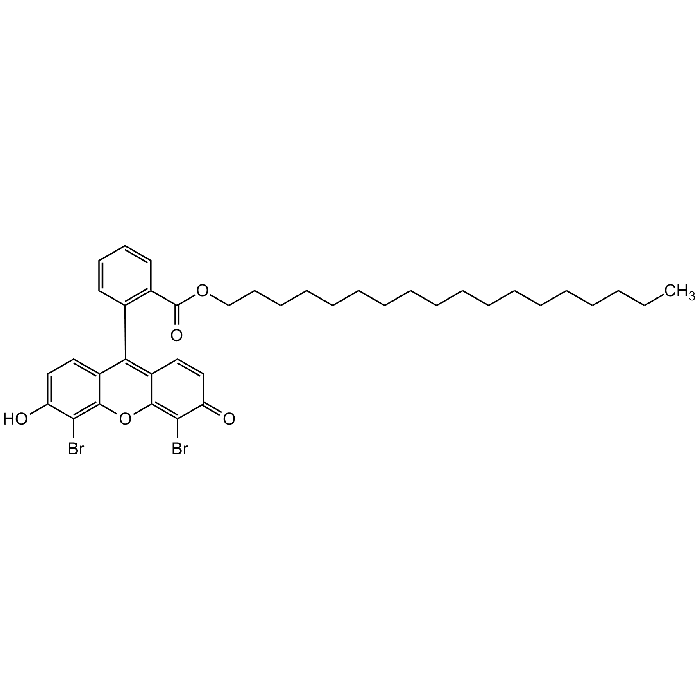Cookie Policy: This site uses cookies to improve your experience. You can find out more about our use of cookies in our Privacy Policy. By continuing to browse this site you agree to our use of cookies.
Chemodex
Chromoionophore VI

| Product Details | |
|---|---|
| Synonyms | 4',5'-Dibromofluorescein octadecyl ester; ETH 7075 |
| Product Type | Chemical |
| Properties | |
| Formula |
C38H46Br2O5 |
| MW | 742.58 |
| CAS | 138833-47-3 |
| Source/Host Chemicals | Synthetic |
| Purity Chemicals | ≥95% (NMR) |
| Appearance | Red to deep orange-red powder. |
| Solubility | Slightly soluble in DMSO, ethanol or methanol. |
| Identity | Determined by 1H-NMR. |
| Declaration | Manufactured by Chemodex. |
| Other Product Data |
Click here for Original Manufacturer Product Datasheet |
| InChi Key | CIRQTSPKAXLQLF-UHFFFAOYSA-N |
| Smiles | O=C1C(Br)=C2OC3=C(Br)C(O)=CC=C3C(C4=C(C(OCCCCCCCCCCCCCCCCCC)=O)C=CC=C4)=C2C=C1 |
| Shipping and Handling | |
| Shipping | AMBIENT |
| Short Term Storage | +4°C |
| Long Term Storage | +4°C |
| Handling Advice | Protect from light and moisture. |
| Use/Stability | Stable for at least 2 years after receipt when stored at +4°C. |
| Documents | |
| Product Specification Sheet | |
| Datasheet |
 Download PDF Download PDF |
Chromoionophore VI (ETH 7075), a synthetic compound composed of a chromophore and an ionophore; is as an acidic lipophilic pH indicator and is generally used during the fabrication of optical sensors/membranes. Chromoionophore VI has been designed to selectively interact with transition metal ions, such as copper, nickel, and zinc, and to produce a fluorescent signal in response to their presence. This property makes Chromoionophore VI an attractive tool for studying the processes by which these metals are transported and utilized in biological systems and a wide variety of biological processes, including apoptosis, oxidative stress, and metal ion homeostasis. Chromoionophore VI is a powerful tool for studying the interactions between ions and molecules, as well as for studying the effects of ionic strength on biochemical and physiological processes. It can also be used to study the structure and function of proteins, lipids and carbohydrates or the effects of light on cells and tissues, as well as to measure the rate of enzyme-catalyzed reactions. Spectral Data: λex 530nm, λem 560nm, λmax ~537nm. Chromoionophore VI can be used as an analytical tool for the detection and quantification of certain metal ions in solution. When Chromoionophore VI is exposed to a metal ion of interest, it undergoes a conformational change that alters its fluorescent properties, causing an increase in its fluorescence intensity, lifetime or spectral shift. This change can then be detected and quantified using techniques such as fluorescence spectroscopy or microscopy. The concentration of the target ion can be estimated by developing a calibration curve based on the response of the Chromoionophore VI signal to a range of known metal ion concentrations. The compound has been shown to be capable of selectively detecting and imaging different metal ions, such as zinc, copper, and nickel in live cells, allowing researchers to track their movement and concentration over time.
(1) S.S.S. Tan, et al.; Anal. Chim. Acta 255, 35 (1991) | (2) Y. Mi & E. Bakker; J. Electrochem. Soc. 144, L27 (1997) | (3) C. Demuth & U.E. Spichiger; Anal. Chim. Acta 355, 259 (1997) | (4) I.H.R. Badr; Anal. Lett. 34, 2019 (2001) | (5) I.H.R. Badr & M.E. Mexerhoff; JACS 127, 5318 (2005) | (6) M.M. Erena, et al.; ACS Sens. 4, 421 (2019) | (7) X. Du, et al; Biomicrofluidics 16, 31301 (2022) | (8) M.M. Taha, et al.; Sensors 22, 7135 (2022)





